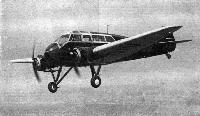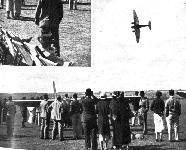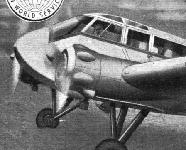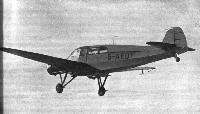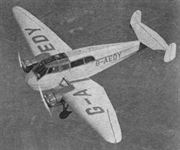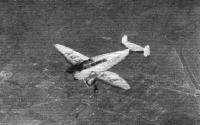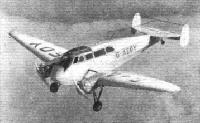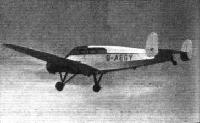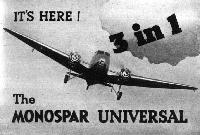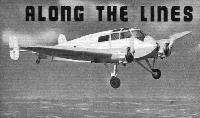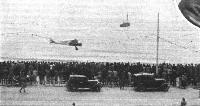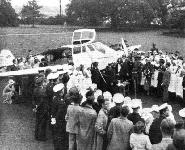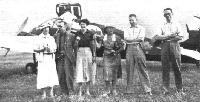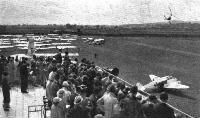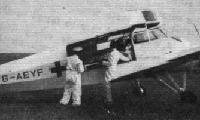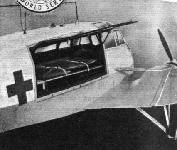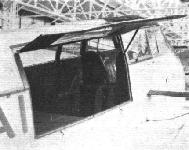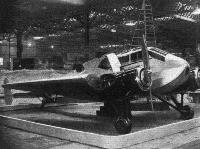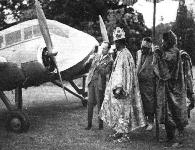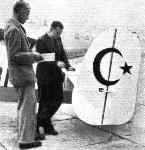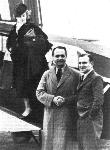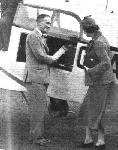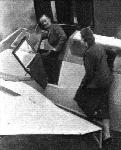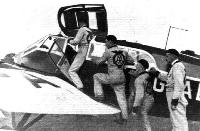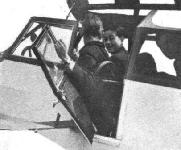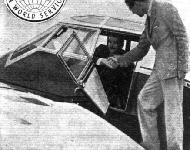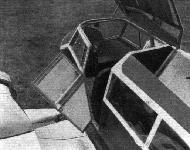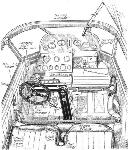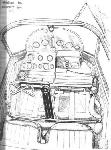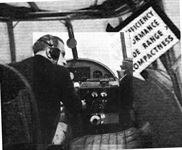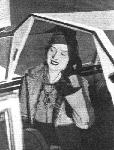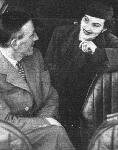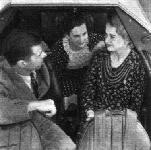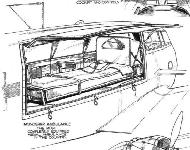
Описание
Страна : Великобритания
Год : 1935
Четырех/пятиместный легкий пассажирский самолет
Варианты
- General Aircraft - Monospar ST-25 Universal - 1935 - Великобритания
- General Aircraft - GAL.41 - 1939 - Великобритания
General Aircraft Monospar ST-25 Jubilee и Universal
В 1935 году в воздух поднялся прототип самолета, получившего обозначение Monospar ST-25 и собственное наименование Jubilee в честь 25-летнего юбилея правления короля Георга V. Фактически ST-25 представлял собой улучшенный вариант ST-10. В задней части салона, в отличие от ST-10, установили откидное сиденье для пятого пассажира, остекление продлили в сторону хвостовой части, а силовая установка состояла из двух звездообразных моторов Pobjoy Niagara II.
Популярный Monospar ST-25 серийно выпускался до 1939 года. По ходу производства в конструкцию вносились изменения, а в конце 1936 года для лучшей путевой устойчивости в полете на одном работающем моторе однокилевое оперение заменили двухкилевым. Двухкилевые самолеты сохранили старое обозначение, но получили новое наименование Universal, на них стояли более мощные моторы Niagara III. Всего построили 59 самолетов: 30 Jubilee и 29 Universal. Был разработан санитарный вариант Monospar ST-25 - с большой дверью в правом борту фюзеляжа, позволявшей выполнять погрузку и разгрузку носилок с больным. В салоне имелось сиденье для санитара. Первый экземпляр данного варианта использовался в Великобритании как демонстратор. Несколько Ambulance поставили на экспорт. На пяти грузовых Freighter сохранили большую дверь в правом борту фюзеляжа, но размеры ее увеличили - данные пять машин закупил заказчик из Канады.
Варианты
Monospar ST-25 De Luxe: один самолет Jubilee с триммерами, килем увеличенной площади и моторами Niagara III с электростартерами; переоборудован до уровня Universal
G.A.L.26: один экспериментальный Monospar ST-25 Jubilee с двумя моторами Blackburn Cirrus Minor мощностью по 90 л.с.
G.A.L.41: один Monospar ST-25 с экспериментальной гермокабиной, с наддувом от мотоциклетного мотора Douglas Sprite мощностью 27 л.с.
T42: один Monospar ST-25, построенный в 1937 году, испытывался с экспериментальным трехопорным шасси
ТАКТИКО-ТЕХНИЧЕСКИЕ ХАРАКТЕРИСТИКИ
General Aircraft Monospar ST-25 Universal
Тип: четырех/пятиместный легкий пассажирский самолет
Силовая установка: два звездообразных ПД Pobjoy Niagara III мощностью по 95 л. с. (71 кВт)
Летные характеристики: максимальная скорость на оптимальной высоте 211 км/ч; крейсерская скорость на оптимальной высоте 185 км/ч; начальная скороподъемность 216 м/мин; практический потолок 4665 м; дальность 676 км
Масса: пустого 825 кг; максимальная взлетная 1304 кг
Размеры: размах крыла 12,24 м; длина 7,72 м; высота 2,39 м; площадь крыла 20,16 м2
Описание:
- General Aircraft Monospar ST-25 Jubilee и Universal
- Flight, June 1935
STANDARDISED EQUIPMENT - Flight, April 1936
FIVE MONOSPARS - Flight, April 1936
MODERN LIGHT AIRCRAFT REVIEWED - Flight, June 1936
MONOSPAR MODIFICATIONS - Flight, March 1938
British light aircraft - Flight, October 1938
British Commercial Aircraft
Фотографии
-
Flight 1935-06 / Flight
The new Monospar S.T.25.
-
Flight 1935-12 / Flight
A small fast monoplane. The Monospar Jubilee.
-
Flight 1935-09 / Flight
The Jubilee Monospar crosses the finishing line after averaging 122.5 m.p.h. in the hands of K. G. Seth-Smith
-
Flight 1936-07 / Flight
The Monospar is being demonstrated by Mr. Seth-Smith while the interested spectators engulf Mr. Lowe's Swift
Другие самолёты на фотографии: Comper Swift / CLA.7 - Великобритания - 1930
-
Flight 1937-10 / Flight Advertisements
First cost and maintenance ... economy here is vital in twin-engine flying training. The Military Trainer version of the Monospar provides really economical training in twin-engine flying, photography, bombing, aerial gunnery, radio and navigation. Moreover, it easily carries all necessary military equipment.
-
Flight 1935-09 / Flight
Регистрационный номер: G-ADPI BACK FROM THE CONTINENT: In this Monospar Jubilee model, recently purchased by the Vacuum Oil Company, Mr. W. Faust (director) and Mr. H. J. White (aviation sales manager and pilot have been touring their agencies in many countries on the Continent Mr. E. C. Gordon England, joint managing director of General Aircraft Ltd., the makers of the Monospar, was also on board.
-
Aeroplane Monthly 1988-04 / J.Stroud - Wings of Peace
Регистрационный номер: G-ADPK Crilly Airways ST.25J G-ADPK.
-
Aeroplane Monthly 1988-10 / Personal album. Civil
Регистрационный номер: G-ADVH, X9365 General Aircraft Monospar ST-25 Jubilee G-ADVH, first registered in October 1935, seen at Heston in 1938, when it was owned by Flt Lt G. Shaw and kept at RAF Thomaby. After impressment into the RAF as X9365 in March 1940 the Monospar was flown on Army cooperation dive-bombing exercises. On April 4, 1940 X9365 overdid it, dived into trees at Saighton Military Camp and was destroyed. Monospars were promptly withdrawn from such duties.
-
Aeroplane Monthly 1991-10 / Personal album. Civil
Регистрационный номер: G-ADWH, F-AQAD General Aircraft Monospar ST-25 Jubilee G-ADWH was built at Hanworth in 1935 and appears to have remained with its parent company until it was sold in France as F-AQAD in May 1937. The ST-25 was powered by two 90 h.p. Pobjoy Niagara II radial engines.
-
Aeroplane Monthly 1988-04 / J.Stroud - Wings of Peace
Регистрационный номер: G-AEDY [9] G-AEDY as the ST.25 De Luxe, with enlarged fin.
-
Flight 1936-04 / Flight
Регистрационный номер: G-AEDY [9] The plan form of the S.T.25 wing is admirably shown in the flying picture. The position of the adjustable landing light in the nose can be seen in the view.
-
Flight 1936-04 / Flight
Регистрационный номер: G-AEDY [9] The picture gives a good impression of the wide field of view available for both pilot and passengers.
-
Air-Britain Archive 1980-02
Регистрационный номер: G-AEDY [9] There simply was not room in ARCHIVE No.1 for all the available material but to prove that you can't keep a good photo down here is Monospar G-AEDY - from the UK C of A section where other examples are also to be found in this edition.
-
Flight 1938-03 / Flight
Регистрационный номер: G-AEDY [9] The smaller Pobjoy-engined Monospar S.T.25.
-
Flight 1936-08 / Flight Advertisements
Регистрационный номер: G-AEDY [9] -
Flight 1936-09 / Flight Advertisements
Регистрационный номер: G-AEDY [9] -
Flight 1936-07 / Flight
Регистрационный номер: G-AEDY [9] General Aircraft was represented by the standard type 25 and the Monospar Ambulance, Florence Nightingale, both with Pobjoy Niagara engines.
-
Aeroplane Monthly 1988-04 / J.Stroud - Wings of Peace
Регистрационный номер: G-AEDY [9] A folded Monospar, in this case G-AEDY after being converted to become the first ST.25U or Universal.
-
Flight 1936-07 / Flight Advertisements
Регистрационный номер: G-AEGY [6] -
Flight 1936-07 / Flight Advertisements
Регистрационный номер: G-AEGY [6] -
Flight 1937-03 / Flight
Регистрационный номер: G-AEGY [6] The latest Monospar De Luxe, which, in standard form, is fully equipped for day, night and blind flying with four occupants and their luggage.
-
Aeroplane Monthly 1988-04 / J.Stroud - Wings of Peace
Регистрационный номер: G-AEGY [6] The G.A. Monospar "Universal" Four-seat Cabin Monoplane (two 90 h.p. Pobjoy "Niagara" engines).
G-AEGY, the first production ST.25U. -
Flight 1936-06 / Flight
Регистрационный номер: G-AEGY [6] The S.T.25 in its latest form. The increase in dihedral will be noticed by those who are familiar with the machine.
-
Flight 1937-09 / Flight Advertisements
Modern insistence on Safety and Comfort demands that the large transport aeroplane of to-day be given two or more engines. Every reason exists for giving the smaller machine the same advantages. Pioneering, the Monospar was the first practical, small twin-engined aeroplane and it is to-day the liveliest and least expensive 4-seater in its class.
-
Flight 1937-06 / Flight
Some idea of the conditions prevailing at Douglas on Saturday can be gathered from this photograph of the first machine home - Mr. J. A. M. Henderson's Monospar - crossing the line at zero altitude.
-
Flight 1936-05 / Flight
Регистрационный номер: G-AEGX [3] The Monospar Ambulance (two Pobjoys) should find many applications in Scandinavia.
-
Flight 1936-08 / Flight Advertisements
Регистрационный номер: G-AEGX [3] Florence Nightingale - первый экземпляр ST-25 Ambulance. Больного на носилках загружали в кабину через большую дверь в правом борту фюзеляжа. Все построенные Ambulance были экспортированы.
-
Flight 1936-06 / Flight
Mrs. Mollison christens the Monospar ambulance for the British Red Cross Society.
-
Flight 1936-07 / Flight
A group of participants: Miss de Paula, Mr. D. R. Pobjoy, Miss Cleyton, Mrs. Pobjoy, Mr. Whitton and Mr. Jackson. In the background is the Monospar S.T.25 (two Pobjoys) flown by Mr. C. E. Gardner. Incidentally, this machine returned in one day, leaving Budapest at 7.45 a.m. and reaching Lympne at 5.45 p.m.
-
Flight 1936-08 / Flight
A general view of the scene at the Eastbourne Club's "At Home" immediately prior to the prize-giving, with some of the club members and guests in the tea enclosure and the Monospar Ambulance on the left.
-
Flight 1936-06 / Flight
Some idea of the number of visitors and machines can be gathered from these photographs, though only about a third of the visiting machines can be seen. In the left-hand picture the Monospar Ambulance can be seen in the foreground, while Mr. Brie is demonstrating the Autogiro.
Другие самолёты на фотографии: Cierva/Avro C.30A / Rota - Великобритания - 1932
-
Aeroplane Monthly 1988-04 / J.Stroud - Wings of Peace
Регистрационный номер: G-AEGX [3] The first ST.25J ambulance, G-AEGX Florence Nightingale.
-
Flight 1937-07 / Flight Advertisements
Регистрационный номер: G-AEYF Press photo of the successful Monospar actually taken during the competition. The MONOSPAR AMBULANCE.
-
Flight 1937-03 / Flight Advertisements
Регистрационный номер: YR-SAN YR-SAN, a fully equipped Monospar Ambulance, has recently been despatched by air to Industria Aeronautica Romana, the Roumanian State Aircraft Factory. This machine, besides its main purpose of carrying sick persons to Hospitals from remote districts, is capable of bringing a doctor and full equipment in cases of sudden illness. Interior and fittings have been designed under the auspices of the British Red Cross Society and include every essential for the care and transporting of the sick or injured. This Monospar is not merely for first aid; it is a small but veritable flying hospital whose speed and smoothness in the air will be or immense benefit in a task where these points mean so much.
-
Flight 1937-11 / Flight
The Monospar Universal is, as its name implies, intended as a convertible type for a number of uses. The cabin may be seen in ambulance and freighter form in the pictures; normally there are four chairs, and the machine can be considered either as a luxury private-owner type or as a feeder-line proposition.
-
Flight 1936-10 / Flight
FREIGHTER: The loading hatch of the Monospar freighter.
-
Flight 1937-08 / Flight Advertisements
The moderate climate of England is very different from the extremes of heat and cold met with in many parts of the world where aircraft operate. Both moisture and excessive dryness are enemies of wood. Monospars are therefore entirely of metal, which is carefully proofed against corrosion, and needs practically no maintenance under any climatic conditions.
-
Flight 1937-02 / Flight
One of two complete aircraft at Castle Bromwich - the De Luxe Monospar shown by General Aircraft Ltd. Behind the machine is an uncovered wing. The other make exhibited is an Aeronca.
-
Flight 1936-11 / Flight Advertisements
Here is the "City of Halifax" - one of the five Monospars in the first British air fleet ever ordered by Canada, the once-impregnable stronghold of transatlantic manufacturers. Eastern Canada Airlines operate under particularly difficult conditions, with bitter cold, much snow and dangerous flying country. After long deliberation, they have chosen the Monospar as being the most reliable and best-equipped machine for their freight and passenger services. Another example of the suitability of Monospar in World Service!
-
Flight 1937-06 / Flight
HANWORTH HOSPITALITY: During the visit last week of Ademola II, Alake of Abeokuta, Nigeria, to the London Air Park Lord Sempill explained various points of the latest Monospar and flew the Alake round for about half an hour.
-
Aeroplane Monthly 1999-06 / P.Jarrett - Creatures of the air /Strange plumage/
This fearsome beast is the Pobjoy-engined General Aircraft Monospar ST-25 which took part in Event 5, “Big Game Shooting”, at the RAF Display at Hendon on June 26, 1937. In the event, a “noted big game shot”, alias Wg Cdr D.V. Carnegie flying an ancient Renault-powered “Horace” Farman F.40 (now part of the RAF Museum’s collection), accompanied by his “tame ‘dragon’” (the Monospar flown by Flt Lt H. G. Lee), demonstrated a typical day’s shooting of game “selected from a number of monsters said to be found in the stratosphere”.
-
Flight 1937-05 / Flight
MORE HANWORTH HOSPITALITY: General Aircraft Ltd., last week entertained 160 Canadian public schoolboys who are visiting Britain under the auspices of the National Council of Education of Canada. Following the fraternal Hanworth custom the party was also taken to call on Autogiro's, Kronfeld's, B.A., London Air Park Flying Club and Flying Training Ltd. Joy-rides provided the ultimate rapture.
-
Flight 1939-09 / Flight
Nothing to do with the subjects discussed by "Indicator," but Connor Park aerodrome, Australia, with a portion of the town of Rockhampton in the background. It is the mid-way stopping place between Brisbane and rich north-west. Airlines of Australia run a daily service each way with Stinson Trimotors. One of the two Dragons belongs to Aircraft Pty. and is used for carrying Sunday newspapers from Brisbane. The D.H.86 belongs to W. R. Carpenter and was, when the picture was taken, on its way from New Guinea to Sydney. The Monospar belongs to Air Taxis,while the Moth is owned by the Rockhampton branch of the Royal Queensland Aero Club.
Другие самолёты на фотографии: De Havilland Dragon / D.H.84 - Великобритания - 1932De Havilland Express Air Liner / D.H.86 - Великобритания - 1934De Havilland Moth / D.H.60 - Великобритания - 1925
-
Air Enthusiast 1971-09 / The Great Danes /Veteran & Vintage/
Регистрационный номер: OY-DAZ The General Aircraft GAL-25 Monospar OY-DAZ displayed at Egeskov Castle was in use as an ambulance until 1963.
-
Aeroplane Monthly 1979-01 / Personal album
Another aircraft captured from the Republican Air Force was this Monospar ST-25, 31-5, powered by a pair of 95 h.p. Pobjoy Niagara III’s. As the red crosses on the wings reveal, it was used as an ambulance, but it is not possible to see if it has the the large starboard hatch of the purpose-built ambulance version, of which several went for export.
-
Air-Britain Archive 1982-02
Регистрационный номер: ZK-AFF [5], G-AEJW [5] ZK-AFF is the only airworthy Monospar in the world and still appears regularly at displays in New Zealand
-
Aeroplane Monthly 1977-12 / B.Service - Manu Rere
Регистрационный номер: ZK-AFF [5], G-AEJW [5] General Aircraft Monospar Universal.
-
Air Pictorial 1976-03
Регистрационный номер: ZK-AFF [5], G-AEJW [5] General Aircraft Monospar ZK-AFF (ex G-AEJW, c/n. 84) at Hastings, New Zealand. Last airworthy example of its type, it is used for aerial survey work by New Zealand Aerial Mapping and is expected to take part in the Royal New Zealand Aero Club Pageant at Palmerston this month, on 13th March 1976
-
Aeroplane Monthly 1977-12 / B.Service - Manu Rere
Регистрационный номер: ZK-AFF [5], G-AEJW [5] New Zealand Aerial Mapping's ST-25 Universal has extra glazing under the nose to facilitate aerial photography. The twin fins and rudders of the ST-25 distinguished it from its predecessors.
-
Aeroplane Monthly 1977-12 / B.Service - Manu Rere
Регистрационный номер: ZK-AFF [5], G-AEJW [5] New Zealand Aerial Mapping's ST-25 Universal has extra glazing under the nose to facilitate aerial photography. The twin fins and rudders of the ST-25 distinguished it from its predecessors.
-
Flight 1937-03 / Flight Advertisements
Регистрационный номер: TC-TK4 -
Flight 1937-10 / Flight
STAR AND CRESCENT: Messrs. R. H. Somerset and L. Castlemaine, the General Aircraft pilots who left Hanworth on Sunday with two Monospars for delivery to the Turkish Air League, which will use them for instruction in parachute jumping. The doors of the machines have been slightly modified for the purpose.
-
Flight 1936-04 / Flight
Регистрационный номер: K8307 FOR BLIND APPROACHES: One of two Monospar S.T.25s which have been equipped for the wireless flight at Farnborough. This machine has full dual control, with a hood for one pilot, Lear direction-finding equipment, Sperry Horizon and directional gyro, a Reid and Sigrist turn indicator, a Kollsman sensitive altimeter and Smith rate of climb indicator.
-
Aeroplane Monthly 1984-02 / A.Lumsden, T.Heffernan - Probe Probare (2)
Further view of the ST-25, taken in 1937 when the aircraft bore the Class B markings T42. The ST-25 was powered by two 95 h.p. Pobjoy Niagara III engines.
-
Aeroplane Monthly 1984-02 / A.Lumsden, T.Heffernan - Probe Probare (2)
Further view of the ST-25, taken in 1937 when the aircraft bore the Class B markings T42. The ST-25 was powered by two 95 h.p. Pobjoy Niagara III engines.
-
Aeroplane Monthly 1984-02 / A.Lumsden, T.Heffernan - Probe Probare (2)
An earlier view of the same aircraft bearing the Class B markings T42, taken the previous year.
-
Aeroplane Monthly 1984-02 / A.Lumsden, T.Heffernan - Probe Probare (2)
Регистрационный номер: N1531 The ST-25, bearing the RAF serial number N1531, arriving at Hanworth aerodrome on May 31, 1938.
-
Aeroplane Monthly 1984-02 / A.Lumsden, T.Heffernan - Probe Probare (2)
The tricycle ST-25 photographed during its period under test by the A&AEE at Martlesham during November 1937
-
Flight 1937-11 / Flight
One of our own experiments in this tricycle business - the Monospar. It is, on conventional unconventional lines, for application to pushers and multi-engined types.
-
Flight 1936-03 / Flight
Регистрационный номер: YR-NIC YR-NIC are the appropriate registration letters of an S.T.25 Monospar specially built for the personal use of Prince Nicholas of Roumania. The Prince's pilot, Capt. Nicolai Opris (centre) is see bidding farewell to Mr. L. R. E. H. Castlemaine, of General Aircraft, Ltd., before flying the machine home; the lady is Capt. Opris' wife.
-
Flight 1936-07 / Flight
THE FLYING SQUAD: Mr. Tapper, of the A.A., used a Monospar S.T.25 to convey his "air scouts" from point to point during the Week-end Aerien, during which event they performed their usual efficient parking and other ground duties.
-
Flight 1937-05 / Flight
"DIVINE WIND'S" crew see something of British aviation: Messrs. Iinuma and Tsukagoshi, famed for their 100-hour flight from Tokio, recently enjoyed the hospitality of that section of the Industry which centres on Hanworth. They are seen off for a trip with Mr. R. Somerset in a Monospar. They were also introduced - by Mr. R. A. C. Brie - to rotating wings.
-
Flight 1935-11 / Flight
"HOMING" TO THE BALTIC: Last Saturday Messrs. H. C. Macphail and R. Ker (right) took off from Hanworth with a Jubilee Monospar fitted with R.T.E. visual homing equipment for a European tour. They will visit Denmark, Sweden, Norway, Lithuania, Latvia, Esthonia and Finland in the course of their tour.
-
Flight 1935-06 / Flight
The cabin door arrangement; the new curved screen is also visible.
-
Aeroplane Monthly 1993-08 / C.Prower - From Brisfit to Beverley: Gliding into battle 2 (5)
Регистрационный номер: G-AGDN This photograph of a Hamilcar being towed by a Halifax was taken from General Aircraft’s ST-25 Monospar G-AGDN in June 1944.
Другие самолёты на фотографии: General Aircraft Hamilcar / GAL.49 - Великобритания - 1942Handley Page Halifax A/C / Halton - Великобритания - 1942
-
Flight 1936-06 / Flight
A demonstrating pilot's view of the airport buildings - and the crowd. The photograph was taken from the Monospar while Mr. Seth-Smith was making his "fly-past.''
-
Aeroplane Monthly 1988-04 / J.Stroud - Wings of Peace
The forward part of the cabin of an ST.25, with swing-over controls.
-
Aeroplane Monthly 1977-12 / B.Service - Manu Rere
New Zealand Aerial Mapping's ST-25 Universal has extra glazing under the nose to facilitate aerial photography. The control wheel can be swung over to the right for use by a second pilot.
-
Flight 1938-01 / Flight
The instrumental equipment of one of the Monospars used at Farnborough for blind-approach experiments. The special millibar correction scale on the sensitive altimeter is interesting and it may be possible to read the notice above it which orders that two millibars should be added to the barometric pressure given. Two millibars are, in fact, equal to 60 feet at sea level. An altimeter-guided approach has its dangers.
-
Flight 1936-04 / Flight
The control and instrument layout of the new De Luxe model. In its production form the "pull" starters seen below the control wheel will not appear, since the Niagara III engines are fitted with Rotax electric starters
-
Flight 1937-03 / Flight
The DeLuxe Monospar has a spectacle-type swing-over control column, and an excellent instrument layout.
-
Flight 1939-04 / Flight
This view of the Hennes Transreceiver two-way aircraft radio equipment gives a good idea of its compact size. (General Aircraft Ltd.).
-
Flight 1936-04 / Flight
There is plenty of light in the Monospar cabin and the machine can be flown from either of the two front seats. When used as a four-seater that in the foreground folds away, leaving a wide shelf for luggage which can be reached, if desired, through a separate door.
-
Flight 1938-03 / Flight
The hinged panel of the Monospar Universal is designed for ambulance and freighter work, fifth seat may be "manufactured" from tne luggage tray at the rear of the cabin.
-
Flight 1936-07 / Flight
Monospar Ambulance. Interior, showing nurses seat and general equipment
-
Flight 1936-07 / Flight
Monospar Ambulance. The most completely equipped aerial ambulance in the country
-
Flight 1936-04 / Flight
The two sketches on the left show one of the aileron tab balances and the jacking pad beneath the axle, while the new tab trimmers on rudder and elevator can be seen above.
- Фотографии
